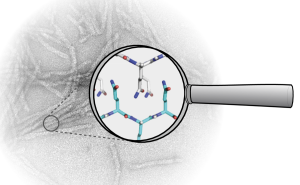
One challenge in the effective application of NMR methods is to achieve sufficient sensitivity for a given sample condition or concentration. This sometimes results in a need for relatively large sample sizes or long acquisition times. Recent developments in NMR hardware and methodology dramatically increase the sensitivity through the use of dynamic nuclear polarization (DNP) [1,3]. This technique uses the inherently (much!) larger polarization on electrons to enhance the nuclear NMR signals. Various experimental implementations aimed at biological NMR now exist [3,4]. Combining low temperature DNP with magic angle spinning NMR now allows for exciting new studies of biomolecular and other solids, including in particular also studies of unlabeled materials. Such experiments for example allowed a 120-fold enhancement for isotopically labeled amyloid-like GNNQQNY nanocrystals [1] but also multidimensional ssNMR studies of unlabelled protein aggregates associated with Huntington’s disease [2,5]. This paves the way for studies of aggregates where labeling is difficult or impossible, for instance for ex vivo materials from patients, cell models and model animals.
References
- Van der Wel, P.C.A. et al. (2006) “Dynamic nuclear polarization of amyloidogenic peptide nanocrystals: GNNQQNY, a core segment of the yeast prion protein Sup35p.” J. Am. Chem. Soc. 128:10840-10846
- Smith et al. (2018) “Structural Fingerprinting of Protein Aggregates by Dynamic Nuclear Polarization-Enhanced Solid-State NMR at Natural Isotopic Abundance” J. Am. Chem. Soc. 140(44): 14576-80
- Barnes et al. (2008) “High field dynamic nuclear polarization for solid and solution biological NMR” App. Magn. Reson. 34(3-4) 237-263
- Maly et al. (2008) “Dynamic nuclear polarization at high magnetic fields” J. Chem. Phys. 128(1): 052211
- Smith, et al. (2023) Fast Magic Angle Spinning for the Characterization of Milligram Quantities of Organic and Biological Solids at Natural Isotopic Abundance by 13C–13C Correlation DNP-Enhanced NMR. Solid State Nuclear Magnetic Resonance 2023, 123, 101850. https://doi.org/10.1016/j.ssnmr.2022.101850.